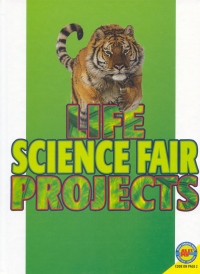| ________________
CM . . . . Volume XVIII Number 22 . . . . February 10, 2012
excerpt:
Part of the four-volume "Science Fair Projects" series, this title is also an AV² media enhanced book. It begins with some basic information about how to take part in a science fair and eight steps to a great project, followed by six different topics from which to choose in the area of life science- birds, the human body, insects, plants, bacteria and the food chain. A double-page spread is devoted to each topic which is introduced with some background information. A fairly simple experiment follows, with instructions, a list of materials, tips, level of difficulty rating, the estimated time required to complete the experiment, and, if applicable, cautionary notes in icon form. These icons indicate, for example, that the experiment might be messy, wet, or costly or might require the assistance of an adult. Most of the materials used in the experiments are common household objects although some would involve a trip to a local science supply store (e.g. the bacteria experiment requires petri dishes). Experiments include creating various styles of duck feet out of yogurt container lids to find out which design works best for swimming; finding one's active and resting heart rates; observing ants to find out how they react to different types of food; growing corn or bean seeds in various conditions; observing bacteria growth in petri dishes after swabbing four different household objects; and researching two animals- one herbivore and one carnivore- that live in the same habitat and creating a food chain poster. The book ends with information about preparing a report, setting up a display board, and information about how to impress the science fair judges. Many of these tips seem too brief, but there is a great deal of information to enhance these tips once the reader employs the AV² website. A table of contents, a glossary and an index are provided. The book has an attractive layout and there are several colour photographs to suit each topic. Using the AV² aspect of the book brings the information to a new level. According to the publisher, the AV² media enhanced books provide a "multi-faceted learning experience" for students with activities designed to foster higher level thinking, to promote various strategies for reading comprehension, and to develop other core topics, such as understanding cause and effect, making comparisons, making inferences, sequencing, and differentiating fact from opinion. Once readers access the AV² website, they enter a code found on the second page of the book. They will be asked to turn to a specific page and enter a security code word- for example, what is the last word on page 17? (These security questions change with each subsequent visit to the site, so the reader actually has to have the book in hand.) There are related web activities for each double-page spread, including downloadable observation lists, project timelines, project evaluation checklists for the student and an adult to fill out, and examples of judges' questions to answer. A video clip, showing how a duck's feet propel him through water, relates to the yogurt container lid experiment, while instructions on how to build an ant farm and drawing doodlebugs relate to the ant experiment. Other activities include an interactive game which teaches about microorganisms, articles and quizzes about the human body, a food chain and food web demonstration, and a video showing, in time-lapse photography, the growth of radish sprouts. Finally, there are presentation ideas and tips on how to create a winning science fair project, including some excellent, practical do's and don'ts, such as not gluing three-dimensional objects onto a display board at home- instead, bring the glue to the science fair and affix the object on site. Reputable educational websites, such as Discovery Education, provide many of the activities and are unlikely to change in the near future. There is even a section of a linked site that offers helpful tips for teachers who are have taken on the role of science fair coordinator. As a stand-alone book, this title is only fairly good, but with the AV² option, its value is greatly enhanced. Recommended. Gail Hamilton is a former teacher-librarian in Winnipeg, MB.
To comment
on this title or this review, send mail to cm@umanitoba.ca.
Copyright © the Manitoba Library Association. Reproduction for personal
use is permitted only if this copyright notice is maintained. Any
other reproduction is prohibited without permission.
NEXT REVIEW |
TABLE OF CONTENTS FOR THIS ISSUE
- February 10, 2012.
AUTHORS |
TITLES |
MEDIA REVIEWS |
PROFILES |
BACK ISSUES |
SEARCH |
CMARCHIVE |
HOME |
